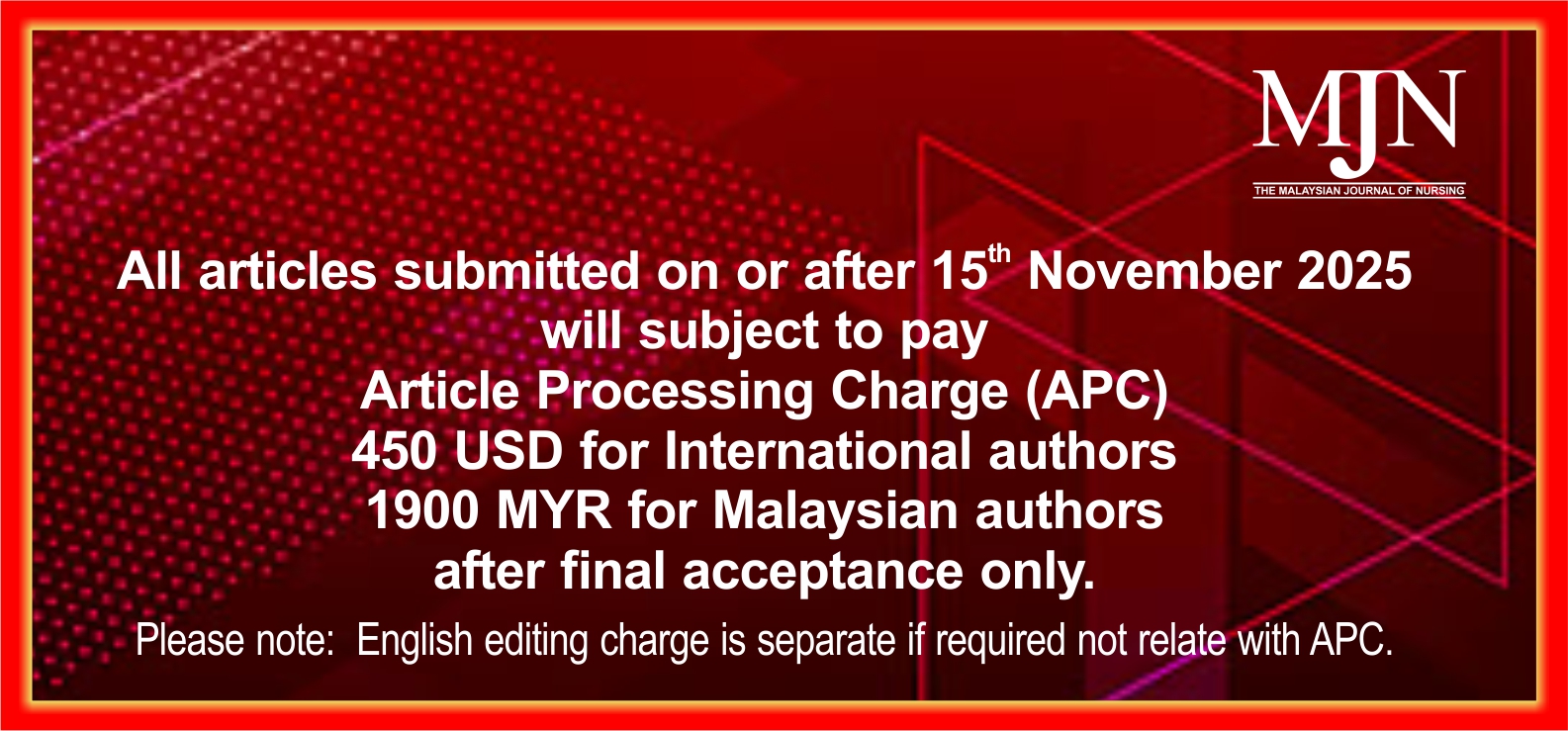A Comparative Study on the Differences in Knowledge, Attitude, and Behavior Regarding Sexual and Reproductive Health (SRH) among High School Adolescents in Kendari City, Indonesia
DOI:
https://doi.org/10.31674/mjn.2023.v15i01.010Abstract
Background: Globalization has facilitated the rapid and unhindered growth of communication processes and information dissemination. This phenomenon has resulted in accelerated changes in behavior among adolescents, particularly regarding sexual behavior. As a consequence, sexual and reproductive health (SRH) problems have become an important issue for adolescents in Indonesia. Therefore, the government needs to pay special attention to the needs of adolescents, considering that the population at this age is very large compared to people in other groups. Objective: This study aims to compare differences in knowledge, attitude, and behavior among adolescents about SRH in the control and intervention groups. Methods: A true experimental design was used with two groups consisting of the control and intervention groups. The control group in this study was not given intervention, while the case group received targeted actions. Results: Based on the Wilcoxon sign rank test for knowledge and attitude variables in the control group, the Asymptotic Significance (asymp. sig.) (2-tailed) value was 0.029, while that of behavior was 0.000. For the intervention group, all variables had an Asymp. Sig (2-tailed) value of 0.000. Conclusion: Knowledge, attitude, and behavior of school adolescents showed significant differences after being given intervention about SRH.
Keywords:
Adolescents, Health Education, Sexual and Reproductive HealthDownloads
References
Abaño, G. A. O. (2018). A Cross-Country Systematic Literature Review on Young Adults’knowledge and Awareness on HIV/AIDS. Malaysian Journal of Medical Research (MJMR), 2(4), 60-63. https://doi.org/10.31674/mjmr.2018.v02i04.008
Amin, S. (2017). HIV/AIDS knowledge level among undergraduate health science students in a private university, Malaysia. Malaysian Journal of Medical Research (MJMR), 1(1), 1-7. https://ejournal.lucp.net/index.php/mjmr/article/view/100 , Accessed on July 1st, 2023
Arista, F. S., & Kuswanto, H. (2018). Virtual physics laboratory application based on the android smartphone to improve learning independence and conceptual understanding. International Journal of Instruction, 11(1), 1–16. https://doi.org/10.12973/iji.2018.1111a
Brunelli, L., Bravo, G., Romanese, F., Righini, M., Lesa, L., De Odorico, A., ... & Brusaferro, S. (2022). Sexual and reproductive health-related knowledge, attitudes and support network of Italian adolescents. Public Health in Practice, 3, 100253. https://doi.org/10.1016/j.puhip.2022.100253
Budiman, L. S., & Listyaningsih, U. (2020). Differences in adolescent knowledge about Generation Planning (GenRe) based on the characteristics of adolescents in the Ngepring Family Planning Village. IOP Conference Series: Earth and Environmental Science, 451(1). https://doi.org/10.1088/1755-1315/451/1/012045
Chandra-Mouli, V., Lane, C., & Wong, S. (2015). What does not work in adolescent sexual and reproductive health: a review of evidence on interventions commonly accepted as best practices. Global Health: Science and Practice, 3(3), 333-340. https://doi.org/10.9745/GHSP-D-15-00126
Damayanti, M., Wirakusumah, F. F., & Anwar, R. (2018). Reproductive health game (KEPO game) to the self-concept and adolescent reproductive health motivation. GMHC, 6(3), 162-8 .https://doi.org/10.29313/gmhc.v6i3.2897
Decker, M. J., Atyam, T. V., Zárate, C. G., Bayer, A. M., Bautista, C., & Saphir, M. (2021). Adolescents’ perceived barriers to accessing sexual and reproductive health services in California: a cross-sectional survey. BMC Health Services Research, 21(1), 1–12. https://doi.org/10.1186/s12913-021-07278-3
Gavin, L. E., Catalano, R. F., David-Ferdon, C., Gloppen, K. M., & Markham, C. M. (2010). A review of positive youth development programs that promote adolescent sexual and reproductive health. Journal of adolescent Health, 46(3), S75-S91. https://doi.org/10.1016/j.jadohealth.2009.11.215
Gebreselassie, B. (2015). Assessment of Reproductive Health Service Utilization and Associated Factors Among Adolescents (15-19 Years Old) in Goba Town, Southeast Ethiopia. American Journal of Health Research, 3(4), 203. https://doi.org/10.11648/j.ajhr.20150304.12
Hasan, S. S. (2017). Impact of Health Educational Program upon Caregivers’knowledge and Practices for Psychosocial Problems of Acute Leukemia Adolescent Patients. Malaysian Journal of Medical Research (MJMR), 1(4), 12-17. https://ejournal.lucp.net/index.php/mjmr/article/view/276 , Accessed on July 5th, 2023.
Hindin, M. J., & Fatusi, A. O. (2009). Adolescent sexual and reproductive health in developing countries: an overview of trends and interventions. International Perspectives on Sexual and Reproductive Health, 35(2), 58-62. https://doi.org/10.1016/j.jadohealth.2016.05.022
Indonesia Demographic and Health Survey 2017 (2018). National Population and Family Planning Board Jakarta, Indonesia, Statistics Indonesia, Jakarta, Indonesia. Ministry of Health Jakarta, Indonesia. The DHS Program ICF Rockville, Maryland, USA. https://dhsprogram.com/pubs/pdf/FR342/FR342.pdf , Accessed on June 25th, 2023.
Leekuan, P., Kane, R., Sukwong, P., & Kulnitichai, W. (2022). Understanding sexual and reproductive health from the perspective of late adolescents in Northern Thailand: a phenomenological study. Reproductive Health, 19(1), 230. https://doi.org/10.1186/s12978-022-01528-1
Mediå, L. M., Sigurdardottir, S., Fauske, L., & Waehre, A. (2023). Understanding sexual health concerns among adolescents and young adults with differences of sex development: a qualitative study. International Journal of Qualitative Studies on Health and Well-Being, 18(1). https://doi.org/10.1080/17482631.2023.2204635
Nurmala, I., Hargono, R., Siswantara, P., Harris, N., Wiseman, N., Roche, E., ... & Fitriani, H. U. (2020). Effectiveness of Adolescent Reproductive Health Media in HEY (Health Educator for Youth) Activities for High School Students in Indonesia. International Journal of Innovation, Creativity and Change, 11(10), 653-666. https://repository.unair.ac.id/123644/ , Accessed on June 19th, 2023.
Safitri, D. (2020). The Effect of Using Appsgeyser.Com-Assisted Android Applications on Student Learning Outcomes in Social Science Subjects at 74 Public Elementary Schools in Bengkulu City. https://repository.iainbengkulu.ac.id/6300/ , Accessed on June 28th, 2023.
Sugiarto, H. (2018). Application of Multimedia Development Life Cycle in Applications Recognition of Alphabets and Numbers. IJCIT (Indonesian Journal on Computer and Information Technology), 3(1), 26–31. https://doi.org/10.31294/ijcit.v3i1.3753
Sumaryani, S., Ningrum, S. A. W., Prihatiningsih, T. S., Haryanti, F., & Gunadi, A. (2021). Peer education and sexual risk behavior among adolescents: Does urban status matter? Open Access Macedonian Journal of Medical Sciences, 9(T4), 50–54. https://doi.org/10.3889/oamjms.2021.5818
Published
How to Cite
Issue
Section
License
Copyright (c) 2023 The Malaysian Journal of Nursing (MJN)

This work is licensed under a Creative Commons Attribution-NonCommercial-NoDerivatives 4.0 International License.



































